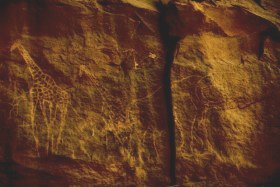
The Sahara pump theory is a hypothesis that explains how flora and fauna migrated between Eurasia and Africa via a land bridge in the Levant region. It posits that extended periods of abundant rainfall lasting many thousands of years (pluvial periods) in Africa are associated with a "wet-green Sahara" phase, during which larger lakes and more rivers existed.[1] This caused changes in the flora and fauna found in the area. Migration along the river corridor was halted when, during a desert phase 1.8–0.8 million years ago (mya), the Nile ceased to flow completely[clarification needed][2][3] and possibly flowed only temporarily in other periods[4] due to the geologic uplift (Nubian Swell) of the Nile River region.
- ^ van Zinderen-Bakker E. M. (1962-04-14). "A Late-Glacial and Post-Glacial Climatic Correlation between East Africa and Europe". Nature. 194 (4824): 201–203. Bibcode:1962Natur.194..201V. doi:10.1038/194201a0. S2CID 186244151.
- ^ "Structural Controls Of The Egyptian Nile". Archived from the original on 2010-08-31. Retrieved 2009-06-27.
- ^ Lansbery, Leslie (2011). Geological and geomorphological evolution of the Egyptian Nile between Aswan and Kom Ombo: A remote sensing and field study approach (MS). Missouri University of Science and Technology.
- ^ Williams, Martin A.J.; Talbot, Michael R. (2009). "Late Quaternary Environments in the Nile Basin". The Nile. Monographiae Biologicae. Vol. 89. pp. 61–72. doi:10.1007/978-1-4020-9726-3_4. ISBN 978-1-4020-9725-6.